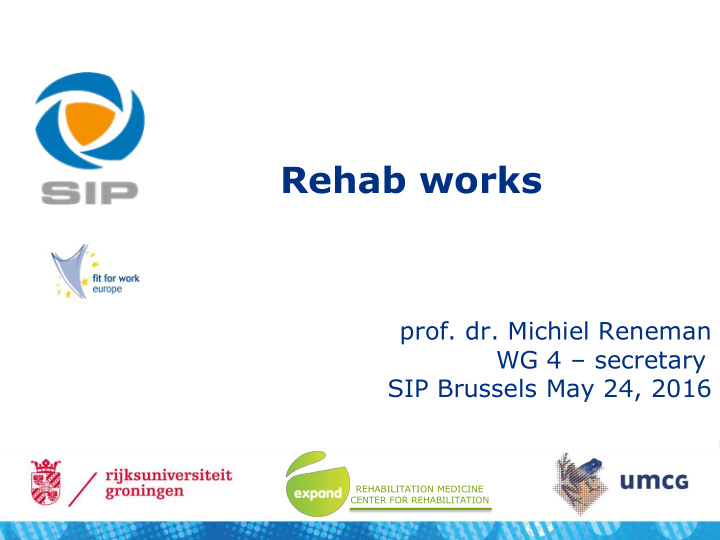



Rehab works prof. dr. Michiel Reneman WG 4 – secretary SIP Brussels May 24, 2016 REHABILITATION MEDICINE CENTER FOR REHABILITATION
Pain and Work: what’s known Chronic Pain 1. 20% adult EU citizens 2. Major economic impact – main impact driver: WORK 80% 26% 17% 13% 8% 7 days 4 weeks 7weeks 12 weeks 6 months
Study 4: Work ability and work performance (0-10) Stay at work with pain • possible • slight loss Baseline Rehab • substantial loss Pain Self-Efficacy consistently explained higher WA and WP
Independent review: 'Is Work Good for Health and Well- being?‘ Commissioned by the UK Department for Work and Pensions Waddell en Burton, 2006 Impact of work on health and well-being • Strong evidence showing that work is generally good for physical and mental health and well-being. • Overall, the beneficial effects of work outweigh the risks of work, and are greater than the harmful effects of long- term unemployment or prolonged sickness absence. • Worklessness is associated with poorer physical and mental health and well being. Work can be therapeutic and can reverse the adverse health effects of unemployment. That is true for healthy people of working age, for many disabled people, for most people with common health problems and for social security beneficiaries. The provisors are that account must be taken of the nature and the quality of work and its social context; jobs must be safe and accommodating.
Prevention of work disability • It can be done • It should be done How? Comprehensive program, including: • Vocational Rehabilitation • Public Education • System changes • Healthy Aging @ Work
Vocational Rehabilitation Whatever works to get people to return to work and / or stay at work… 7
Vocational rehab with chronic musculoskeletal pain: effective and cost-effective Effective • Better work participation • Less disability Professional evidence based • Less pain guidelines e.g. Cost B-13 Cost-effective • Ratio 1:5 • Largest benefit: work participation However : silo’s between health and employment
Vocational Rehab: Working principles 1. Bio-psycho-social perspective in assessment and treatment – Work focused health care 2. Gradual increase in activities and work – Modified work 3. Shared goal and plan: client / worker – work – rehab team – RTW Coordinator 4. Timing / stepped and matched care – ~ 2-4 months
Public education • Basic assumption: beliefs guide behaviors • Pain beliefs: pathology needs rest to heal • Changing beliefs has been focus of public campaigns • Alignment with policies • Messages: be active, stay at work (modified), work heals … Australia, Canada, Norway, Scotland Netherlands: preparations Europe ???
Example Montana USA: Work heals
Example Montana USA: Work heals
Pain and Work: Challenges 1. (Evidence Based) Vocational Rehab not available for all EU citizens 2. Modified work not available for all EU citizens 3. Silos between health and work policies hinder RTW and SAW 4. Beliefs about Pain and Work: not evidence based 5. Aging workforce: physical decline and increase chronic diseases Present and future missed opportunities for • Patient / worker, Employers, Countries, EU 15
16
Rehab works – summary slide 1. VR: proven effective and cost efficient; rehab works! 2. VR / modified work / silos: fix system flaws 3. Public education 4. New technology to assist Healthy Aging @ Work Prevention of work disability It can be done – it should be done
Thank you m.f.reneman@umcg.nl REHABILITATION MEDICINE CENTER FOR REHABILITATION
Recommend
More recommend